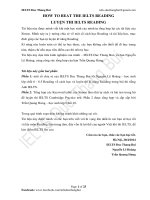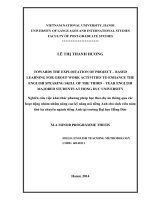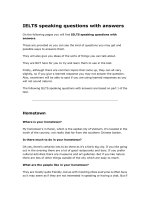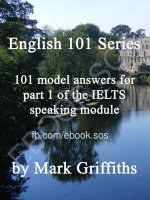31 High Scoring Formulas to Answer the IELTS Speaking Question
Bạn đang xem bản rút gọn của tài liệu. Xem và tải ngay bản đầy đủ của tài liệu tại đây (15.44 MB, 465 trang )
Jonathan Palley - Adrian Li - Oliver Davies
31 High-scoring
Formulas to
Preface
Looking back at your past time of speaking English or your latest conversation with a foreigner, did you
encounter any of the following problems: so embarrassed that you were empty-minded? thinking of many
aspects but not knowing which one to begin with? knowing the answer but unable to express it in English
fluently?
31 High-scoring Formulas to Answer the IELTS Speaking Questions can help IELTS candidates solve the
problems of "not knowing what to say" and "not knowing how to say it" in the Speaking test. These 31 highscoring formulas are designed based on effective strategies to deal with actual IELTS Speaking test
questions. They cover nearly all topics in the real Speaking test. Mastering them enables the candidates to
answer every question naturally and confidently in order to get the highest score possible at their level of
proficiency.
Take one common question in the IELTS Speaking test as an example, "How often do you play sports?"
So many candidates would answer "Yes, I play sports every day." The answer may sound grammatically
correct, but it fails to earn them a decent score on the IELTS Speaking test. In fact, with this type of question,
it is expected that candidates would apply the order of forming responses similar to the following model:
Step i : Forming the answer
* Say how frequently you do the activity the examiner asks you about. * Explain why you do it that
frequently.
Step 2: Applying language skills to elicit the answer
* Use a range of different adverbs of frequency correctly.
I play badminton very often. I never go skiing.
If candidates follow the recommended steps of forming the answer, their responses will be more coherent
and well structured. Based on this high-scoring formula, an expected response may be "I play sports a few
times a week, Usually I play basketball with my friends, but sometimes I play football instead. I think team
sports are a great way to socialise and keep fit." Compared to the answer "Yes, I play sports every day," this
response is clearly richer and more detailed in content, and more accurate and natural in using language
expressions.
Once you have mastered this high-scoring formula, all questions which start with "How often...?" will be
solved easily. For example, "How often do you eat in restaurants?, How often do you go for a long walk?,
How often do you take public transport?", etc.
Just in the same manner, a good grasp of 31 essential high-scoring formulas in this book can allow
candidates to answer every IELTS Speaking test question with confidence and great effectiveness.
Contents
Overview
of
the
IELTS
Speaking
Test
How to Use 31 High-scoring Formulas to Answer the IELTS Speaking Questions
9
Part ONE
Introduction to Part One Formulas
Formula I:
Formula 2:
Formula 3:
Formula 4:
Formula 5: Formula 6:
Formula 7: Formula 8:
Formula 9:
Formula 10:
Formula Il:
Do you prefer X to Y?
13
What do you usually /normally do?—
What do you like to do (in your spare time)?28
What do you dislike about X?
20
— 34 How often do you do X?—
What do you like most about X?
—47
Is X popular (in your country)?—
What is the best time (of year) to do X?
61
Why do some people like X?
— 69
When was the first/last time you did X?
— 76
40
Did you ever learn to do X?
84
Formula 12: How has X changed?91
Formula 13: How would you
improve
97
Formula 14:
How important is X?
103
Formula 15:
110
What do you want/hope to do (in the future)?
Formula 16:
116
Do people do/get enough X?
Formula 17:
How can people find out about X?
— 122
Formula 18:
Should people be given X?.
— 128
Formula 19:
Is it diffcult to do
— 135
Formula 20:
Is X suitable for (types of people)E
141
4
Contents
Part two
Introduction to Part Two Formulas—147
149
Formula 21: Person Monologue
Formula 22: Place Monologue
177
Formula 23: Object Monologue
—204
Formula 24: Past Event Monologue
234
Part
Introduction to Part Three Formulas.
—267
Formula 25: Giving and Supporting Opinions—269
Formula 26: Evaluating Two Different Opinions279
Formula 27: Agreeing and Disagreeing289
Formula 28: Talking about Advantages and Disadvantages
300
Formula 29: Expressing Importance and Priority
310
—
Formula
30:
Proposing
Solutions
to
Problems—
Formula 31: Speculating about Future Events and Outcomes—
329
Appendices
Top 10 Do's and Don'ts for the IELTS Speaking Tesu
Verbs
Answer Key
343
Most
Commonly
339
Misused
by
IELTS
-
5
Overview ofthe IELTS Speaking Test
The IELTS Speaking test is divided into 3 parts:
Part 1
Part 1 lasts for 4-5 minutes. The examiner will ask you some familiar questions
about your hometown, family, hobbies, acquaintances, etc. You are supposed to
answer the questions briefly and accurately, along with specific examples.
Part 1 aims to test the candidate's ability to discuss familiar topics and use simple
English grammar.
Part 2
Part 2 lasts between 3 and 4 minutes. The examiner will ask you to give a
personal monologue about a certain topic for 1-2 minutes. You will be given a cue
card on which there are points you should cover. You have I minute for preparation;
meanwhile, you will be provided with a pen and paper to jot down some main ideas.
Part 2 aims to test the ability of speaking in long turns.
Hints for high scores
details thåt can make
ypui
at the ctWOßamples bélow.
'Idijo•j]
My
les o yhen; (hoyealhec. iSDleayant.„ was,
Obe iifiiénIiåtÄVe
lit!
-bui+till' coiildo'i• liiul
Note;. When
i'j•oni)
Oijswei'$j/
MonauallédÄn(I' [Old unne thaiåC',
Ing:eneral, Ihe
should,
o i' l)laee, nee, you have io •1011
WIiOpvyOtCgO
lilåce. etc,
Part 3
In Part 3 of the IELTS Speaking test, which lasts 4-5 minutes, you will
participate in a discussion with the examiner based on the topic in Part 2. You should
express and support your opinion clearly, as well as show your skills of using
English in discussing various topics in depth.
Part 3 aims to test the candidate's ability to express personal interpretations of
argumentative issues and to discuss them in detail.
Hints for high scores
Look uåUihéåW9ßårnpléS below,]
Sample
préhlein€lliéiog the Avoj'ld ('Odoy?
Low-scoring answer;, al problem faciÅg (lie woi'ld.
a
How to Use 31 High-scoring Formulas
to Answer the IELTS Speaking
Questions
Structure of the Book
This book can be used either for self-study or as in-class training material. 31 Highscoring Formulas to Answer the IELTS Speaking Questions consists of 3 parts corresponding
to the IELTS Speaking test components.
Part I: 20 high-scoring formulas for IELTS Speaking Test Part One
Part 2: 4 high-scoring formulas for IELTS Speaking Test Part Two
Part 8: 7 high-scoring formulas for IELTS Speaking Test Part Three
Each formula consists of 2 sections: Answer order and Language steps. Answer order shows you "what to say",
which indicates the logic of an answer needed for a speaking test question type; and Language steps show you "how
to say it", which includes detailed vocabulary and grammar you need to communicate your ideas.
Learning Strategies
It is recommended that you follow the order of content presented in this book,
starting with the basic and easier content first to set a firm base for your speaking
skill. To maximise your learning results, consider these following steps:
I. Clearly understand the purposes and content of each chapter. After every chapter,
check to see whether you have achieved what is intended for that chapter.
2. Master both Answer order and Language steps. Through Answer order, learn how to
think logically like natives to plan your answers; through Language steps, learn the
vocabulary and grammar needed for your answers.
3. Acquire new vocabulary by doing the vocabulary exercises and using these words into
practical conversation.
4. Read the model answers and note down how important words and structures are used in context.
5. Study the explanation of model examples and practise with extensive exercises for more
accurate expressions and richer answers.
6, Work through the material with your friends, if possible, You all can ask and answer
in turn to practise the high-scoring formulas.
9
10
ve
Part
Introduction to Part One Formulas
Introduction 10 Part I of the I lil ,F 11S Speaking • l'est:
Pa 1 01 (he IliCl'S Speaking test lasts •l + tninutes.
iner asks you sotne [alnilia r ques[ions ahoul your lionu•lown.
lath ily, 110blsies,
nces, etc.
You shoiild give brief and accurate answers wi [h specil ic
General Introduction to Part I Fornuulas:
The
included in this parl ol' ilie book are based extensi a ncl
thorougli research into '•eal test quesi and intended help you deal
wit li- any IEI ,'I'.S Pa rd I question with
„and elllectiveness.
12
Formula 1
Do you prefer X to Y?
Aims
In this lesson you'll master the Formula for Do you prefer X to Y? type questions.
Do you prefer writing letters or sending emails?
Do you prefer talking on the phone or chatting online?
Do you prefer to travel by bike or on foot?
The formula
When the examiner asks you Do you prefer X to Y? type questions, you must:
14
Part One
Native speaker words
Let's learn some native speaker words which are useful for answering this type of
question.
These words can also help you understand the model answers on the next page more
thoroughly
Speaker•Wordi
*Speech
traffc jam
smiley
noun
convenient adjective
actually
adverb
adjective/ online
adverb
means of transport
sociable
adjective
J)efiiiifiOii
get stuck
15
fitting in well with a
person's needs or plans
in fact; really (usually
used before a slightly
surprising statement)
to get into a situation
when you cannot move
easily (It can be used in
an abstract or a specific
situation. It is often used
when you cannot move in
a tramc jam.) a lot of
vehicles
very
close
together so that they
cannot move
16
all the different types of Is it convenient for you to meet
transport: cars, buses, trains, the Friday afternoon?
subway, planes, etc.
Many people think that
philosophy is really boring, but
it's actually quite fascinating
when you start finding out about
a small image used in chat rooms it.
online by users to indicate
different emotions (It can also be We got stuck in traffic for hours
sent by mobile phone or email. and so we missed our plane.
Example: 0)
on the Intemet
Traffic jams are usually just
caused by the amount of cars on
describing somebody who likes the road, rather than by
meeting new people or spending accidents. This is why there are
time with people
Part One
always traffic jams during
rush hour.
Although
a car is
probably the most popular
means of transport, it is
not very suitable for
modern life in cities,
where they are too
expensive and there is
enough space to drive them.
not I won't let my child surf the Web;
there are too many dangerous
Whenever I make a joke about and dirty things online.
somebody while I am on the Mark isn't a very sociable person
Internet and I worry that at all; he hardly ever goes out to
somebody might get angry, I just have fun and spends all his time
put a smiley at the end of my alone in his room playing
message to show I was only computer games.
joking.
Model answers
Read the model answers from the two IELTS candidates, Alice and David.
17
Language step I Prefer
Let's look at how the two IELTS candidates, Alice and David, use the verb prefer.
18
Part One
Alice I prefer cycling to travellingby bus...
David Generally, I prefer chatting online...
Obviously, the first thing you need to tell the examiner for this type of question is
whether you prefer X or Y. Prefer can be followed by either verb-ing or to verb.
Notice in the examples below that prefer + verb-ing can be followed by either to or
rather than, but prefer + to verb can only be followed by rather than.
prefer + verb-ing + to /rather than +
verb-ing I prefer cycling to taking the
bus.
I prefer eating to cooking.
I prefer baking cakes at home rather than buying them
in shops. I prefer reading a newspaper rather than
watching TV.
19
prefer + to verb + rather than + verb
I prefer to cycle rather than take the bus.
I prefer to eat rather than cook,
I prefer to bake cakes at home rather than buy them in
shops. I prefer to read a newspaper rather than watcb TV.
Both these forms are correct, and mean exactly the same.
0 Exercise 1.1: Error Correction
Some of the sentences below are incorrect, some are correct. Identify the incorrect
sentences and write the correct sentences in the spaces provided.
1. I prefer to go to the cinema to watch DVDs at home.
2. My sister prefers writing letters to write emails.
3. I prefer to talk with friends on the phone rather than using emails.
20
Part One
4. I much prefer to live in a town rather than a big city.
5. My mother prefers shopping at the market more than in supermarkets.
6. My friends generally prefer to send text messages to talking on the phone.
Language step 2 Comparatives
Let's look again at how the two IELTS candidates, Alice and David, use the
comparatives.
Alice ...Cycling is so much more convenient than taking the bus if you're not
travelling too far. Actually, i€s often faster to go by bike because you don't
get stuck in traffic jams! Cycling is also better for my health than all other
means of transport, including buses.
21
David ...l nearly always find that chatting online can be more sociable as you can
speak to more than one person at the same time. Also, chatting online is
often much more fun because you can send smileys, photos and even
videos!
After you have told the examiner whether you prefer X or Y, you should compare
them, so it's very important to use comparatives correctly. To form the comparative
of an adjective, you should: add -er if the adjective is one syllable long.
add -ier if the adjective has two syllables and ends in
-y. add more before the adjective if it has two or more
syllables.
Look at the table below to see how these rules work.
22
Part One
23
When you compare X and Y, you should use one of the following comparative
structures:
X + be + comparative + than + Y
Watching TV is more interesting than listening to the
radio. Cars are prettier than buses.
X + be + not as + adjective + as + Y
Listening to the radio is not as interesting as watching TV.
Buses are not as pretty as cars.
Exercise 1.2: Multiple Choice
Choose the correct answers to complete the sentences below.
1. My mother prefers to eat at home rather than eat in restaurants because she says it's
_ for one's health.
A. more better
24
B. best
C. better
Part One
2, I think that I prefer student life to working life because we are allowed to be in our attitude and
express ourselves more.
A, more creativity
B. more creative
C. creativer
3. Most people prefer taking the airport express light railway to taking a taxi to the
airport
because it is
A. much quicker
B. more quick
C. more quicker
4. I prefer to go to parties with friends rather than with family — partying with friends is so
much because I can drink Wine and let my hair down!
A. exciting B. excitinger
C. more exciting
5. To be honest, I prefer travelling to work by bus rather than by foot because it's
A. easier B. more easy
C. more easier
6. I don't like taking the subway — it's definitely
A. more comfortable than
B. less comfortable
as the bus.
C. not as comfortable
25









